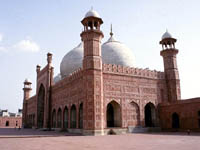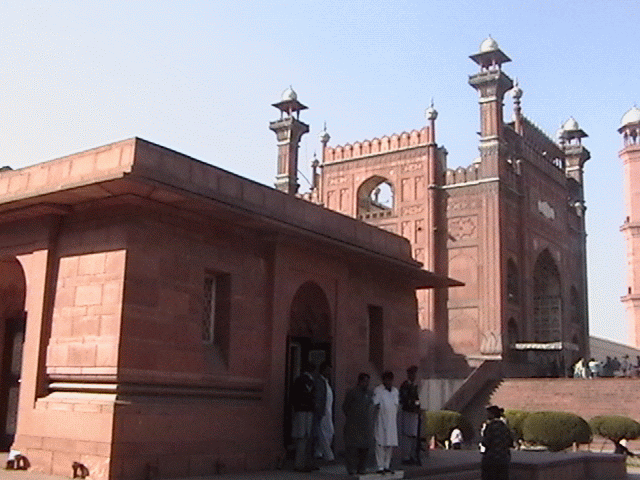

Badshahi Mosque, Lahore

 Entering Lahore from the
Grand Trunk (GT) Road from the north, two landmarks of Lahore come to the
view - the Minar-e-Pakistan and the grand Badshahi Mosque, displaying their
splendours and majestic architecture to the on lookers. It is one of the
city's best known landmarks, and a major tourist attraction, and a reminder
of the beauty and grandeur of the Mughal era architecture.
Entering Lahore from the
Grand Trunk (GT) Road from the north, two landmarks of Lahore come to the
view - the Minar-e-Pakistan and the grand Badshahi Mosque, displaying their
splendours and majestic architecture to the on lookers. It is one of the
city's best known landmarks, and a major tourist attraction, and a reminder
of the beauty and grandeur of the Mughal era architecture.
This grand mosque
with the biggest courtyard of any mosque around the world was built by the
Mogul emperor Aurangzeb in the 17th century (1674 to be exact). Its
construction was completed in a record time of two and a half years. Aurangzeb
built the mosque which is bigger than the Friday Mosque in New Delhi, built
by his father Shah Jehan. The mosque is entirely made of marble and red stand stone. Its
main entrance measures 21.33 meters in length and a courtyard of 161.5 x
160.6 meters. The marble domes cover seven prayer chambers, surrounded by
four minarets at the four corners of the mosque, each with an outer
circumference of 20 meters, soaring up to 54 meters. The walls and roofs of
the prayer halls have tastefully decorated with Islamic calligraphy,
traditional Persian tile sheathing and fresco. The use of stone and marble for
exteriors and interiors lends the mosque a solid monumentality.


The mosque as seen from the Lahore Fort
At the time of its construction, and even many years later, the famous Rover Ravi skirted the ramparts of the Mosque and the Lahore Fort just in front of it. A stream still flaws there and is known as the "Buddha Darya" or the Old River. During the Sikh rules, when Lahore was ruthlessly plundered, many a gems and decorative and ornamental plates both from the Badshahi Mosque and Lahore Fort were removed and sent to Amritsar for the construction of the Golden Temple.



In the chambers above the gate of the mosque (above center), are housed relics attributed to Muhammad (PBUH), the Muslims' Holy Prophet, His Daughter and His Son-in-Law and are said to have been brought to the sub-continent by Amir Taimur. Owing to the religious sensitivities and respect, photography of the relics is strictly prohibited.


Outside the Badshahi Mosque, near its steps lies the tomb of the poet-philosopher Dr Sir Allama Muhammad lqbal. The mausoleum is a mixture of Afghan and Moorish styles of architecture and is constructed entirely of red sandstone, which was brought from Rajasthan. The tomb near the entrance of the mosque was constructed as a mark of respect and pay homage to this great man who gave the very concept of a separate Muslim state for the Muslims of the British India


|
Related Links:
| Badshahi Mosque
Lahore| Courtyard
Sketch | Lahore
History | Photographs - Badshahi
Masjid |
|
|
Copyright©JalalsPages - 2005 |